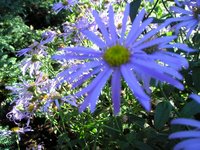 I'm starting to feel almost better, so will be trying to catch up on the blog. On the right is a picture of the excellent freebies that were given to delegates at the Slovenian information literacy conference on 19th October. They included a travel clock and a bag of toiletries from Vichy in a neat lilac bag. Here they are displayed by my hotel bedroom window.
I'm starting to feel almost better, so will be trying to catch up on the blog. On the right is a picture of the excellent freebies that were given to delegates at the Slovenian information literacy conference on 19th October. They included a travel clock and a bag of toiletries from Vichy in a neat lilac bag. Here they are displayed by my hotel bedroom window.There were two talks in English at the conference, one of which was obviously mine. I talked about Information Literacy in Higher Education, and I had to produce a written paper for the proceedings, and a presentation on the day. I started by explaining my view of information literacy and the SCONUL 7 Pillar model. I went on to talk about three levels where there were factors that would influence the way you would approach information literacy education: the national/regional (for example if there were any relevant laws, like the Higher Education law in Sweden) and also the overall approach to education in the country; institutional (the individual institutional culture, any overarching IL frameworks etc.); and at the programme or class level.
In the PowerPoint I talked a little about how my own goal with teaching information literacy was to help students understand the value of information and information literacy to their lives and work. I went on to talk about collaboration between academic and librarian, including reference to our research on academics' conceptions of teaching information literacy. In the written paper I gave some more examples from the literature, whereas I only had time to deal quite briefly with this aspect in the presentation. I finished with my vision of information literacy in HE. Below are links to pdfs of both the written paper and the PowerPoint.
Webber, S. (2006) “Information Literacy in Higher Education.” In: Stopar, K. and Rabzeljl. (Eds) Informacijska Pismenost med teorijo in prakso: vloga visokošolskih in specialnih knjižnic: Zbornik prispevkov. [Information Literacy between theory and practice: The role of academic and special libraries: Proceedings.] Ljubljana: ZBDS. pp9-20. Pdf of the written paper is at http://dis.shef.ac.uk/sheila/webber-sl-06.pdf Pdf of the Powerpoint is at http://dis.shef.ac.uk/sheila/il-ljub-webber.pdf















